Tackle all kinds of paint challenges with help from our Common Issues and Solutions Guide. Choose from the examples below for details on how to repair—and prevent—these everyday problems.
Text and images courtesy of the Rohm & Haas Paint Quality Institute.
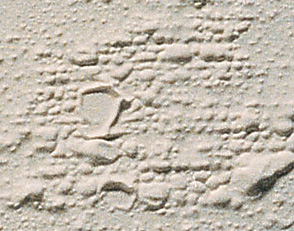
Bubbles resulting from localized loss of adhesion and lifting of the paint film from the underlying surface.
POSSIBLE CAUSE
- Applying oil-based or alkyd paint over a damp or wet surface.
- Moisture seeping into the building through the exterior walls (less likely with latex paint)
- Exposure of latex paint film to high humidity or moisture shortly after paint has dried, especially if there was inadequate surface preparation
SOLUTION
- If blisters do not go all the way down to the substrate: Remove blisters by scraping and sanding, and repaint with a quality acrylic latex interior paint.
- If blisters go down to the substrate: Remove the source of moisture, if possible. Repair loose caulking; consider installing vents or exhauset fans. Remove blisters as above, remembering to prime before applying the finish coat.
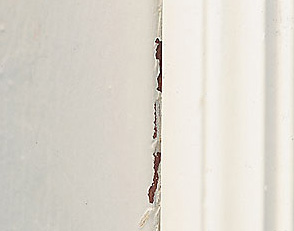
Undesirable sticking together of two painted surfaces when pressed together (e.g., a door sticking to the jamb).
POSSIBLE CAUSE
- Not allowing sufficient dry time for the coating before closing doors or windows.
- Use of low quality semi-gloss or gloss paints.
-
SOLUTION
Use top quality semi-gloss or gloss acrylic latex paint. Low quality latex paints can have poor block resistance, especially in warm, damp conditions. Follow paint label instructions regarding dry times.
Acrylic latex paints generally have better early block resistance than vinyl latex paints, or alkyd or oil-based paints; however, alkyds develop superior block resistance over time. Application of talcum powder can relieve persistent blocking.
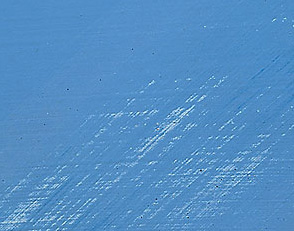
Increase in gloss or sheen of paint film when subjected to rubbing, scrubbing or having an object rub up against it.
POSSIBLE CAUSE
- Use of flat paint in highly trafficked areas, where a higher sheen level would be preferable.
- Frequent washing and spot cleaning.
- Objects (furniture, for example) rubbing against the walls.
- Use of lower grades of paint with poor stain and scrub resistance (see Poor Stain Resistance and Poor Scrub Resistance).
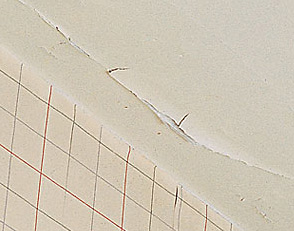
The splitting of a dry paint film through at least one coat as a result of aging, which ultimately will lead to complete failure of the paint. In its early stages, the problem appears as hairline cracks; in its later stages, flaking occurs.
POSSIBLE CAUSE
- Use of a lower quality paint that has inadequate adhesion and flexibility.
- Overthinning or overspreading the paint.
- Inadequate surface preparation, or applying the paint to bare wood without first applying a primer.
- Excessive hardening and embrittlement of alkyd paint as the paint job ages.
SOLUTION
Remove loose and flaking paint with a scraper or wire brush, sanding the surface and feathering the edges. If the flaking occurs in multiple layers of paint, use of a filler may be necessary. Prime bare wood areas before repainting. Use of a top quality primer and top coat should prevent a recurrence of the problem.
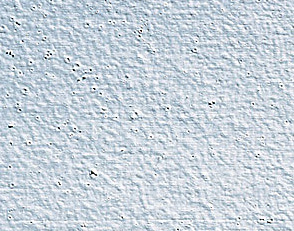
Formation of bubbles (foaming) and resulting small, round concave depressions (cratering) when bubbles break in a paint film, during paint application and drying.
POSSIBLE CAUSE
- Shaking a partially filled can of paint.
- Use of low quality paint or very old latex paint.
- Applying (especially rolling) paint too rapidly.
- Use of a roller cover of low quality, or with wrong nap length.
- Excessive rolling or brushing of the paint.
- Applying a gloss or semi-gloss paint over a porous surface.
SOLUTION
All paints will foam to some degree during application; however, higher quality paints are formulated so the bubbles break while the paint is still wet, allowing for good flow and appearance. Avoid excessive rolling or brushing of the paint or using paint that is more than a year old. Apply gloss and semi-gloss paints with a short nap roller, and apply an appropriate sealer or primer before using such paint over a porous surface. Problem areas should be sanded before repainting.
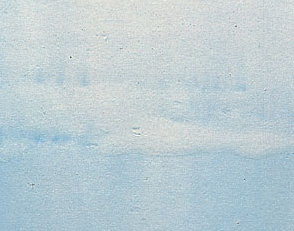
Appearance of a denser color or increased gloss where wet and dry layers overlap during paint application.
POSSIBLE CAUSE
- Failure to maintain a “wet edge” when painting.
- Use of a low solids “economy” paint.
SOLUTION
Maintain a wet edge by applying the paint quickly enough so the paint being applied can still flow in with the just-applied paint. For cut-in work, corners can be brushed immediately after a section has been rolled and the paint is still wet. It is also wise to work in manageable-size areas; plan for interruptions at a natural break, such as a window, door or corner. Using a top quality acrylic latex paint makes it easier to avoid lapping problems because higher solids (pigments and binder) content makes lapped areas less noticeable. If substrate is very porous, it may need a primer/sealer to prevent paint from drying too quickly and reducing wet edge time. Alkyd paints generally have superior wet edge properties.
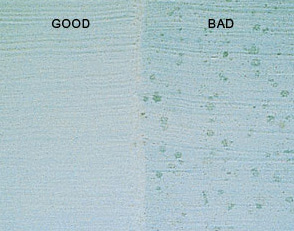
MILDEW
Black, gray or brown spots or areas on the surface of paint or caulk.
POSSIBLE CAUSE
- Forms most often on areas that tend to be damp, or receive little or no direct sunlight (e.g., bathrooms, kitchens and laundry rooms).
- Use of an alkyd or oil-based paint, or lower quality latex paint.
- Failure to prime a bare wood surface before applying the paint.
- Painting over a substrate or coating on which mildew has not been removed.
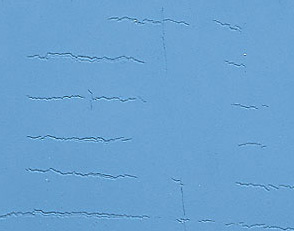
Deep, irregular cracks resembling dried mud, in dry paint film.
POSSIBLE CAUSE
- Paint is applied too thickly, usually over a porous surface. Can occur with inexperienced use of airless spray.
- Paint is applied too thickly, to improve inherent poor hiding (coverage) of a lower quality paint.
- Paint is allowed to build up in corners upon application.
SOLUTION
Remove excess coating by scraping and sanding. Prime and repaint. Mud-cracked areas can also be repaired by sanding the surface smooth before repainting with a top quality latex paint. This type of paint is less likely to exhibit mud cracking, because it is relatively more flexible than alkyd paint, oil-based paint and highly pigmented latex paint. Quality paints have a higher solids content, which reduces the tendency to mud crack. They have good application and hiding properties, which minimize the tendency to apply too thick a coat of paint.
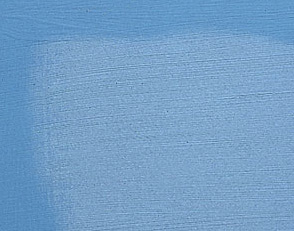
An effect of non-uniform color or sheen that can appear when a wall is painted with a roller, but is brushed at the corners. The brushed areas generally appear darker, resembling the “frame” of a “picture.” Also, sprayed areas may be darker than neighboring sections that are brushed or rolled.
POSSIBLE CAUSE
- Often a hiding (coverage) effect. Brushing will generally result in lower spread rates than rolling, producing a thicker film and more hiding, and sometimes higher sheen.
- Adding colorant to a non-tintable paint or using the wrong type or level of colorant can result in different color development between brushing/rolling/spraying.
SOLUTION
Make sure that spread rates with brushes and rollers are similar. Don”t cut in the entire room before roller coating. Work in smaller sections of the room to maintain a “wet edge.” With tinted paints, be sure the correct colorant-base combinations are used. Factory colors, as well as in-store tints, should be thoroughly shaken at time of sale.
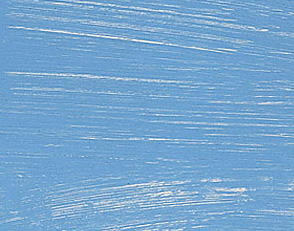
Failure of paint to dry to a smooth film, resulting in unsightly brush and roller marks after the paint dries.
POSSIBLE CAUSE
- Use of lower quality paint.
- Application of additional paint to “touch up” partially dried painted areas.
- Re-brushing or re-rolling partially dried painted areas.
- Use of the wrong type of roller cover or poor quality brush.
SOLUTION
Use top quality latex paints, which are generally formulated with ingredients that enhance paint flow. Brush and roller marks thus tend to “flow out” and form a smooth film. When using a roller, be sure to use a cover with the recommended nap length for the type of paint being used. Use of a high quality brush is important; a poor brush can result in bad flow and leveling with any paint.
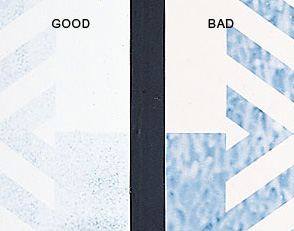
Failure of dried paint to obscure or “hide” the surface to which it is applied.
POSSIBLE CAUSE
- Use of a low quality paint.
- Use of low quality tools/wrong roller cover.
- Use of an improper combination of tinting base and tinting color.
- Poor flow and leveling (see Poor Flow/Leveling).
- Use of a paint that is much lighter in color than the substrate, or that primarily contains low-hiding organic pigments.
- Application of paint at a higher spread rate than recommended.
SOLUTION
If the substrate is significantly darker or is a patterned wallpaper, it should be primed before applying a top coat. Use a top quality paint for better hiding and flow. Use quality tools; use the recommended roller nap, if rolling. Follow manufacturer’s recommendation on spread rate; if using tinted paint, use the correct tinting base. Where a low-hiding organic color must be used, apply a tinted primer first.
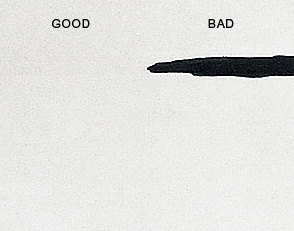
Wearing away or removal of the paint film when scrubbed with a brush, sponge, or cloth.
POSSIBLE CAUSE
- Choosing the wrong sheen for the area.
- Use of a lower quality paint.
- Use of an overly aggressive scrub medium (see Burnishing).
- Inadequate dry time allowed after application of the paint before washing it.
- Application of the paint in too thin a coat.
SOLUTION
Areas that need frequent cleaning require a high quality paint formulated to provide such performance. High traffic areas may require a semi-gloss or gloss paint rather than a flat paint to provide good scrub resistance. Allow adequate dry time, as scrub resistance will not fully develop until the paint is thoroughly cured. Typically, this will be one to two weeks. Try washing the painted surface with the least abrasive material and mildest detergent first.
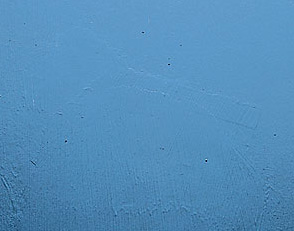
Dull spots or shiny spots (also known as “flashing”) on a painted surface; uneven gloss.
POSSIBLE CAUSE
- Uneven spread rate.
- Failure to properly prime a porous surface, or surface with varying degrees of porosity.
- Poor application resulting in lapping (see Lapping).
SOLUTION
New substrates should be primed/sealed before applying the top coat to ensure a uniform surface. Without the use of a primer or sealer, a second coat of paint will more likely be needed. Often, applying an additional coat will even out sheen irregularities. When rolling paint on, use a top quality roller cover.
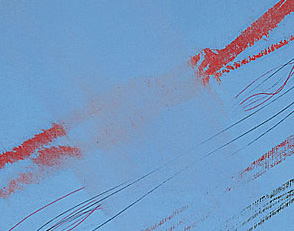
Failure of the paint to resist absorption of dirt and stains.
POSSIBLE CAUSE
- Use of lower quality paint that is porous in nature.
- Application of paint to unprimed substrate.
- Inadequate dry time allowed after application of the paint before washing it.
- Application of the paint in too thin a coat.
SOLUTION
Higher quality latex paints contain more binder, which helps prevent stains from penetrating the painted surface, allowing for easy removal. Priming new surfaces provides maximum sheen and film thickness of a premium top coat, providing very good stain removability. Eggshell and satin paints generally provide better stain resistance, compared with flat paints.
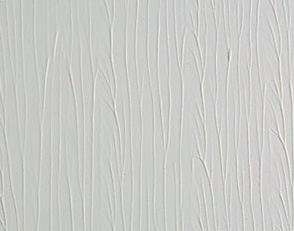
Unintentional textured pattern left in the paint by the roller.
POSSIBLE CAUSE
- Use of incorrect roller cover.
- Use of lower grades of paint.
- Use of low quality roller.
- Use of incorrect rolling technique.
SOLUTION
Use the proper roller cover; avoid too long a nap for the paint and the substrate. Use quality rollers to ensure adequate film thickness and uniformity. High quality paints tend to roll on more evenly due to their higher solids content and leveling properties. Pre-dampen roller covers used with latex paint; remove all excess water. Don’t let paint build up at roller ends. Begin rolling at a corner near the ceiling and work down the wall in three-foot square sections. Spread the paint in a zigzag “M” or “W” pattern, beginning with an upward stroke to minimize spatter; then, without lifting the roller from the surface, fill in the zigzag pattern with even, parallel strokes. Prime porous surfaces.
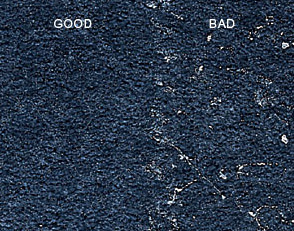
Tendency of a roller to throw off small droplets of paint during application.
POSSIBLE CAUSE
- Use of exterior paint on an interior surface.
- Use of lower grades of latex paints.
- Rolling paint too fast, or with too long a nap.
- Use of low quality roller cover.
- Application of the paint in too thin a coat.
SOLUTION
Higher quality paints are formulated to minimize spattering. Using high quality rollers which have proper resiliency further reduces spattering. In some cases, a quality wall paint may be preferred for ceiling work, for maximum spatter resistance. Overloading the roller with paint will result in excess spatter, as will overworking the paint once it is applied to a substrate.
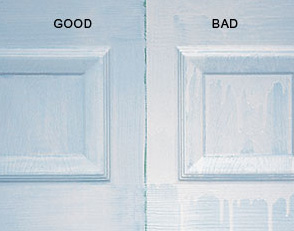
SAGGING
Downward “drooping” movement of the paint immediately after application, resulting in an uneven coating.
POSSIBLE CAUSE
- Application of too heavy a coat of paint.
- Application in excessively humid and/or cool conditions.
- Application of overthinned paint.
- Airless spraying with the gun too close to the substrate being painted, or moving the gun too slowly.
SOLUTION
If paint is still wet, immediately brush out or re-roll to redistribute the excess evenly. If the paint has dried, sand and reapply a new coat of top quality paint. Correct any unfavorable conditions: Do not thin the paint; avoid cool or humid conditions; sand glossy surfaces. Paint should be applied at its recommended spread rate; avoid “heaping on” the paint. Two coats of paint at the recommended spread rate are better than one heavy coat, which can lead to sagging. Consider removing doors to paint them supported horizontally.
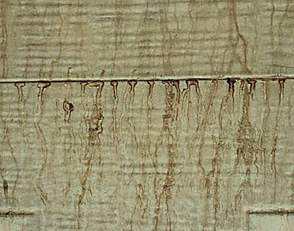
Concentration of water-soluble ingredients on the surface of a latex paint, typically on a ceiling surface in rooms that have high humidity (e.g., shower, bathroom, kitchen); may be evident as tan or brown spots or areas, and can sometimes be glossy, soapy or sticky.
POSSIBLE CAUSE
All latex paint formulas will exhibit this tendency to some extent if applied in areas that repeatedly become humid (bathrooms, for example), especially in ceiling area
SOLUTION
Wash the affected area with soap and water, and rinse. Problem may occur once or twice again before leachable material is completely removed. When paint is applied in a bathroom, it is helpful to have it dry thoroughly before using the shower. Remove all staining before repainting.
